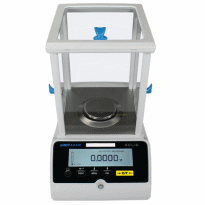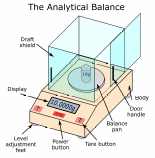Introduction
Analytical balances are laboratory equipment that enables to conduct of precise weights measurements. It consists of a body, flat panel display (LED display), draft shield, door handle, four-level adjustment feet, and buttons. The vital part is a balance pan, on which weights can be put. Analytical balances are common at chemical laboratories, as they are mainly used to measure relatively small weights with high accuracy that is vital for most analysis. Typical objects of measuring are samples of drugs in the form of powder or liquid in containers. The description provides an explanation of analytical balance functioning, characterization of their parts, and technical specification.
Overall Description of Analytical Balances

Analytical balances can vary in the shapes of their pans or bodies, have different colors or different buttons, but most of them have a similar design, as shown in image 1.
It is possible to state that producers of analytical balances try to maintain their products’ most optimal appearance that simplifies their use in laboratories. The standard laboratory balance has readability between 0.1 milligrams (mg.), and 0.01 mg., which implies that it can conduct measurements with an accuracy amounted to 0.01 mg. or 0.00001 gram (g). Simultaneously, the maximum weight that an analytical balance can measure is 320 g. Dimensions of analytical balances are similar and approximately 213*356*338 millimeters: width, depth, and height, respectively. This equipment is sensitive and requires calibration before the exploitation process to ensure its accuracy. It is necessary to use sets of calibration weights with a precise mass that varies in a range between 0.1 mg. to 0.5 g. Moreover, analytical balances require from 1 to 4 seconds to stabilize before the measured weight is correct. The balance operating principle is that the force is measured with an electromagnet, with which weights push the balance pan. It produces an electric current that is proportional to the mass, which activates the light connected to a detector, which eventually makes the display show the number.
Detailed Description of Analytical Balances’ Parts and their Functions

Analytical balances consist of several required parts that are demonstrated on image 2.
Bodies of analytical balances are part, which contains all the internal details and protects them. They are made of stainless steel to be sustainable. Draft shield is the plastic cover of the balance pain integrated into the body. It serves the purpose of a stable measuring process ensuring, as even an airflow can change the results. It has two door handle on it from the right and left sides to enable the user to open and close the draft shield’s doors, put on, or take off weights. Level adjustment feet also serve the purpose of making an analytical balance stable on any surface. They are usually made from rubber that resists gliding. The balance pan is the area on which measuring can be conducted. It is made of stainless steel and sometimes has a protective laying around it that complicates the falling of weights under it. A light-emitting diode (LED) display is the panel that emits light after being affected by a current produced by the electromagnet. It is protected with a plastic screen that can show the numbers and additional information on it. Power, tare, and any other buttons are made of plastic and rubber and enable the equipment’s operation. For instance, the power button fulfills such a function as turning a balance on and off, while the tare button enables to reset the displayed, on the screen, weight to zero. It can be used to eliminate the occasional error of measuring or to measure different weights in the same container.
Conclusion
Analytical balances are highly accurate equipment that is used at different laboratories, such as chemical ones. They enable to conduct precise measurements of weights in a range from 0.01 mg. up to 320 g. Their functioning is based on the direct measuring of force, mass is pushing on the balance pan, and the electromagnet that creates a current equal to this force. This process makes the LED panel show the numbers that mean the weight of the measured object. Laboratory balances are made in the optimal design to ensure their efficiency and are highly valuable during analysis.
References
Adam Equipment Company. (2018). Analytical Balance [Image]. AdamEquipment. Web.
Connelly, A. (2017). Labelled Balance [Image]. AndyJConnelly.Wordpress. Web.